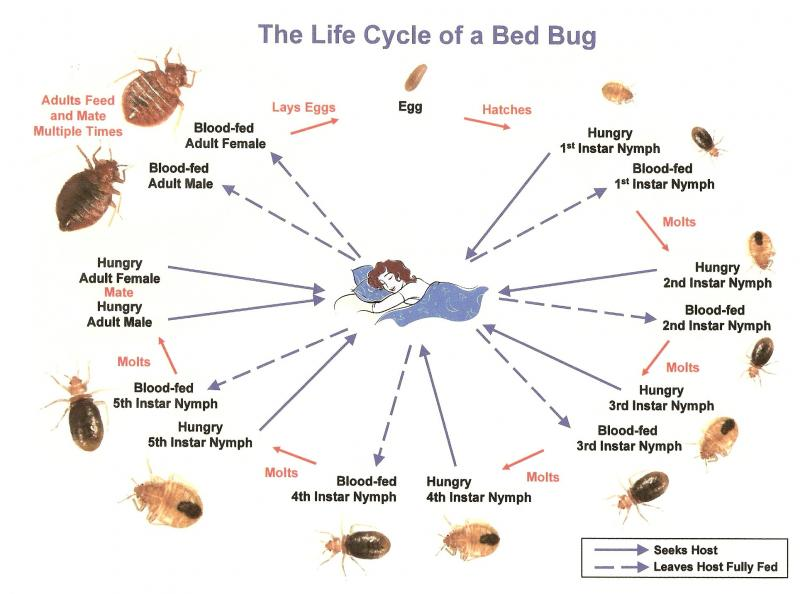If you're curious about the life cycle of bed bugs, you've come to the right place. This article will explore the different stages that bed bugs go through from egg to adulthood, and discuss methods for eradicating these pests from your home. We'll also address some common questions about bed bugs and a condition that affects insect hibernation.
Bed Bug Life Cycle - Introduction
Bed bugs are tiny, reddish-brown pests that survive by feeding on the blood of humans and other warm-blooded creatures. They commonly hide in the seams and joints of mattresses, bed frames, and similar soft furnishings. These insects are primarily active at night, emerging to feed. While bed bugs do not spread diseases, their bites can lead to itching and irritation.
These pests can easily move between locations through contaminated furniture, clothing, or luggage. It's crucial to be diligent and check your sleeping environment, particularly when staying in hotels or new places. If you detect signs of a bed bug infestation, it is essential to contact a professional pest control service right away.
Also Read: Human Life Cycle
Scientific Classification of Bed Bug Life Cycle
- Kingdom: Animalia (animals)
- Phylum: Arthropoda (arthropods)
- Class: Insecta (insects)
- Order: Hemiptera (true bugs)
- Family: Cimicidae (bed bugs)
- Genus: Cimex
- Species: Cimex lectularius (common bed bug)
Where do we find Bed Bugs?
Bed bugs are hitchhikers that travel on clothing, luggage, and furniture, making it easy for them to spread. Once they establish a colony, they can be difficult to eliminate due to their resilience and ability to survive in various environments. These oval-shaped, reddish-brown insects are about the size of an apple seed and can be found worldwide. Bed bugs thrive in a range of conditions, earning them the nickname "bugs without borders."
Life Cycle of Bed Bugs
The life cycle of a bed bug involves different stages:

Egg Stage
Bed bug eggs are small, white, and about the size of a grain of salt. Females can lay one to twelve eggs per day, with an average of five. A single female can produce up to 500 eggs in her lifetime. Eggs are often laid in clusters in hidden areas, such as cracks and crevices. They hatch within two weeks, depending on the temperature.
Also Read: Are We Not Lucky That Plants Reproduce Sexually
Developmental Stages of Bed Bugs
Bed bugs undergo a series of five nymphal stages before reaching adulthood. Each stage involves the bed bugs resembling smaller versions of the adults and requiring blood meals to advance through their development. Under ideal conditions, the transition from an egg to an adult bed bug takes approximately five weeks.
First Nymphal Stage
In the initial nymphal stage, bed bugs start at a length of around 1.5 millimeters. At this stage, they appear as tiny, elongated, and pale creatures with a translucent appearance that has a tint between brown and red. There are no distinctive features at this early phase.
Second Nymphal Stage
As they progress to the second stage, the nymphs grow to about 2 millimeters in length from the initial 1 millimeter. At this point, the bed bugs develop more defined features, including small antennae and a segmented body structure.
Third Nymphal Stage
By the third stage, the nymphs reach approximately 3 millimeters in length and exhibit a more pronounced brownish-red coloration. During this stage, they begin to grow their proboscis, which they use to feed on the blood of their hosts.
Fourth Nymphal Stage
In the fourth stage, the bed bugs measure around 4 millimeters. They become increasingly recognizable due to their more developed features and overall appearance.
Fifth Nymphal Stage
The fifth and final nymphal stage sees the bed bugs reaching about 5 millimeters in length. At this stage, they have matured into their adult form, with a distinct reddish-brown color and a flattened body shape.
Adult
The larvae become adults in about five weeks. It is now safe for them to have babies. Adult bed bugs may not eat every night. The vast majority of people do not react negatively to bed bug bites, to the extent that they do not even realize they have been bitten. It takes six to eighteen months for bed bugs to reach adulthood.
Also Read: Bio Chemical Cycles
Prevention of Bed Bug Life Cycle
Although preventing an infestation of bed bugs might be difficult, the following measures can help:
- Vacuum and steam clean your mattress and bedding often, put bed insect-safe encasements on your mattress and box springs, keep your living space clear of debris, and do not bring in used furniture without first doing a thorough inspection.
- Call a pest control service for help if you think you have a bed bug problem. The key to successfully eliminating any pest infestation is to catch it early and treat it before it multiplies.